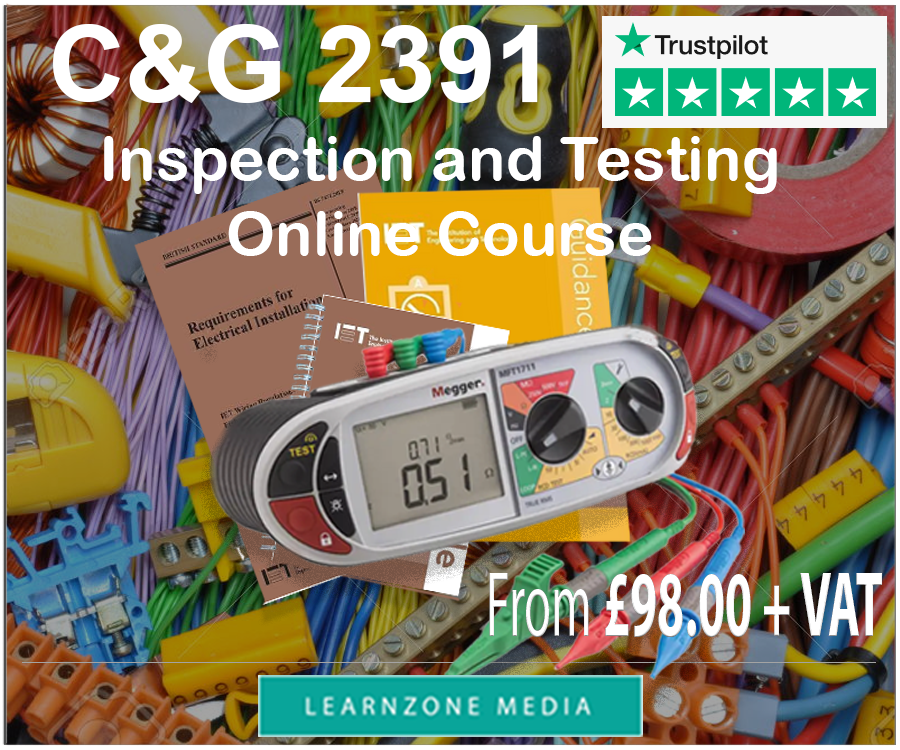C&G 2391 Unit 301 - Sample Test No:3
21. If an insulation resistance lump test at the main switch fuse of a very large installation gave a value of 0.45Mohm the electrician should:
a) Report the entire installation as being unsatisfactory
b) Test each circuit separately
c) Report the entire installation as being satisfactory
d) Reverse the meters test leads and re-test
22. It is recommended that low-resistance ohmmeters used for continuity measurements should have a no-load voltage and a short-circuit current of:
a) Voltage between 4V and 24V; short-circuit current of 200 mA
b) Voltage between 0V and 24V; short-circuit current of 100 mA
c) Voltage between 4V and 20V; short-circuit current of 1 mA
d) Voltage between 0V and 20V; short-circuit current of 1 mA
23. A document for recording information from test equipment would be called
a) Schedule of tests results
b) Schedule of inspection
c)
Inspection schedule
d) Schedule certificate
24. When carrying out a periodic inspection on a public house, which one of the following would not determine the extent and limitation of the report,
a) The licensing authority
b) The fire prevention officer
c) The owner
d) The original designer
25. An earth fault loop impedance tester should only allow current to flow for:
a) 0.4s
b) 4s
c) 40ms
d) 400ms
26. An intrinsically safe test instrument would be used in:
a) Areas oh high ignition risk
b) Cases where extreme accuracy is required
c) Areas with high moisture content
d) High temperature areas
27. It is important to test an installation in the correct sequence because:
a) The sequence is stated in GN3
b) Each test relies on the previous to be correct
c) It is more convenient
d) It is easy to remember
28. When performing an insulation resistance test on a two way lighting circuit, you should:
a) Operate the switches during the test
b) Ensure that both switches are in the off position
c) Ensure that both switches are in the on position
d) Bridge out the switches
29. The measured value of loop impedance for a circuit is 0.83ohm. If the temperature at the time of the test was 20C and the cable is 70C (factor 1.2) what is the corrected value. Ze = 0.4ohm:
a) 0.43 ohm
b) 0.86 ohm
c) 0.996 ohm
d) 0.916 ohm
30. When measuring the resistance of 100m of 2.5mm2 conductor the most suitable range for the instrument would be:
a) 0 to 2 ohm
b) 2 to 10 ohm
c) 10 to 20 ohm
d) 20 to 50 ohm
31. A polarity test is conducted to verify that:
a) Every protective and single pole device is connected to the line conductor only
b) The circuit protection will operate within limits
c) There is no breakdown of the conductor's insulation
d) The resistance is low enough to operate the protective device within the specified time
32. An insulation resistance tester must be capable of delivering a test current of not less than:
a) 0.5 mA
b) 1.0 mA
c) 2.0 mA
d)
20 mA
33. The test current applied to a 30mA RCD to check for a 40ms maximum disconnection time is:
a) 15mA
b) 30mA
c) 150mA
d) 300mA
34. After connection of supply, GN3 recommends polarity should be tested using:
a) An approved ammeter
b) An approved voltage indicator
c) An approved earth fault loop impedance tester
d) An approved insulation resistance tester
35. During periodic inspection, protective conductors must not be disconnected if,
a) The installation can not be isolated from the supply
b) Barriers can not be supplied
c) Previous test results are satisfactory
d) No supervisor is available
36. The easiest method of confirming polarity on a standard ring final socket outlet would be during,
a) The earth electrode test
b) A continuity protective conductors test
c) The earth fault loop impedance test
d) The continuity of ring final conductors test
37. On a small installation containing no distribution circuits, an insulation resistance test can be,
a) Ignored
b) Assumed to be correct
c) Tested as a whole
d) Avoided
38. The correct reading of an earth fault loop impedance test is obtained at,
a) The remote part of the circuit
b) The circuit origin
c) The consumer unit
d) The mid-point of the circuit
39. A test is carried out on an immersion heater circuit to obtain the value of R1 + R2. The meaning of R1 is,
a) The resitance of the protective conductor
b) The resistance of the line conductor
c) The resitance of the insulation
d) The polarity of the circuit
40. A periodic inspection of an existing single phase installation which has 12 circuits protected by BS3036 fuses shows its Ze measured 0.09 ohms. This is potentially dangerous because,
a) It shows no earthing arrangements
b) The prospective fault current may be to high for the circuit protection
c) The BS3036 fuses will not meet the disconnection times
d) The prospective fault current maybe to low






